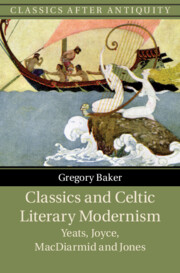Book contents
- Classics and Celtic Literary Modernism
- Classics after Antiquity
- Classics and Celtic Literary Modernism
- Copyright page
- Dedication
- Epigraph
- Contents
- Preface
- Additional material
- Acknowledgments
- Abbreviations
- Introduction
- Chapter 1 “A Noble Vernacular?”
- Chapter 2 “Hellenise It”
- Chapter 3 “Straight Talk, Straight As the Greek!”
- Chapter 4 “Heirs of Romanity”
- Chapter 5 “A Form of Doric Which Is No Dialect in Particular”
- Conclusion
- References
- Index
- References
References
Published online by Cambridge University Press: 20 January 2022
- Classics and Celtic Literary Modernism
- Classics after Antiquity
- Classics and Celtic Literary Modernism
- Copyright page
- Dedication
- Epigraph
- Contents
- Preface
- Additional material
- Acknowledgments
- Abbreviations
- Introduction
- Chapter 1 “A Noble Vernacular?”
- Chapter 2 “Hellenise It”
- Chapter 3 “Straight Talk, Straight As the Greek!”
- Chapter 4 “Heirs of Romanity”
- Chapter 5 “A Form of Doric Which Is No Dialect in Particular”
- Conclusion
- References
- Index
- References
Summary
- Type
- Chapter
- Information
- Classics and Celtic Literary ModernismYeats, Joyce, MacDiarmid and Jones, pp. 257 - 290Publisher: Cambridge University PressPrint publication year: 2022
- Creative Commons
- This content is Open Access and distributed under the terms of the Creative Commons Attribution licence CC-BY-NC-ND 4.0 https://creativecommons.org/cclicenses/

